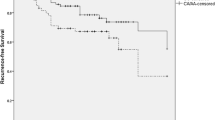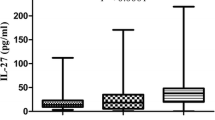Abstract
Purpose
We investigated the relationship between the distribution of the IL-1RN, TNF-β and IL-4 polymorphism and the clinical features of bladder cancer.
Materials and methods
A total of 100 patients with bladder carcinoma and 102 healthy control subjects were enrolled in the study. The IL-1RN, IL-4 and TNF-β gene polymorphisms were identified by PCR restriction fragment length polymorphism-based analysis. Allelic frequencies were compared between patient and the controls. Tumor stage, histopathological grade, tumor size/number and smoking condition were evaluated with IL-1RN, IL-4 and TNF-β gene polymorphisms.
Results
Allele distribution frequencies of IL-1RN and IL-4 gene polymorphisms were significantly different between patients and control groups. However, allele distribution of TNF-β gene was not statistically significant. There was no difference in allele distribution of the three genes in both groups regarding stage, tumor size, number of tumors and smoking condition. Although allele distribution of IL-4 gene showed significant difference considering histopathological grades in both smoking and total patients group, allele distribution of IL-1RN and TNF-β was not different.
Conclusion
The present research suggests that the IL-1RN and IL-4 gene polymorphisms are potential genetic markers of susceptibility to bladder cancer. In the future, clinical improvements on diagnosis, treatment and prognosis of bladder carcinoma are expected owing to development of more sensitive and specific tests for genetic polymorphisms of cytokines that are effective on inflammation.

Similar content being viewed by others
References
Nonomura N, Tokizane T, Nakayama M, Inoue I, Nishimura K, Muramatsu M et al (2006) Possible correlation between polymorphism in the tumor necrosis factor-beta gene and the clinicopathological features of bladder cancer in Japanese patients. Int J Urol 13:971–976
Bid HK, Manchanda PK, Mittal RD (2006) Association of interleukin-1Ra gene polymorphism in patients with bladder cancer: case control study from North India. Urology 67:1099–1104
Tsai FJ, Chang CH, Chen CC, Hsia TC, Chen HY, Chen WC (2005) Interleukin-4 gene intron-3 polymorphism is associated with transitional cell carcinoma of the urinary bladder. BJU Int 95:432–435
Leibovici D, Grossman HB, Dinney PC, Illikan RE, Lerner S, Wang Y et al (2005) Polymorphisms in inflammation genes and bladder cancer: from initiation to recurrence, progression, and survival. J Clin Oncol 24:5746–5756
Balkwill F, Mantovani A (2001) Inflammation and cancer: back to Virchow? Lancet 357:539–545
Bidwell J, Keen L, Gallagher G, Kimberly R, Huizinga T, McDermott MF et al (2001) Cytokine gene polymorphism in human disease. Genes Immun 2:61–70
Galley HF, Webster NR (1996) The immuno-inflammatory cascade. Br J Anaesth 77:11–16
Dinarello CA (1996) Biologic basis for interleukin-1 in disease. Blood 87:2095–2147
Vamvakopoulos JE, Taylor CJ, Morris-Stiff GJ, Green C, Metcalfe S (2002) The IL-1 receptor antagonist gene: a single copy variant of the intron 2 variable number tandem repeat (VNTR) polymorphism. Eur J Immunogenet 29:323–340
Kato S, Onda M, Yamada S, Matsuda N, Tokunaga A, Matsukura N (2001) Association of the interleukin-1 beta genetic polymorphism and gastric cancer risk in Japan. J Gastroenterol 36:696–699
Mittal RD, Mishra DK, Bid HK, Mandhani A (2004) Interleukin-1 receptor antagonist polymorphism in patients with prostate cancer and benign prostatic hyperplasia: a case control study from North India. UroOncology 4:131–134
Mout R, Willemze R, Landegent JE (1991) Repeat polymorphisms in the interleukin-4 gene. Nucleic Acids Res 19:3763
Beutler B, Cerami A (1986) Cachectin and tumour necrosis factor as two sides of the same biological coin. Nature 320:584–588
Warzocha K, Ribeiro P, Bienvenu J, Roy P, Charlot C, Rigal D et al (1998) Genetic polymorphisms in the tumor necrosis factor locus influence non-Hodgkin’s lymphoma outcome. Blood 91:3574–3581
Carvalho MA, Salles TSI, Saad STO (2006) The association of cytokine gene polymorphisms with febrile non-hemolytic transfusion reaction in multitransfused patients. Transfus Med 16:184–191
Hu Z, Shao M, Chen Y, Zhou J, Qian J, Xu L et al (2006) Allele 2 of the interleukin-1 receptor antagonist gene (IL1RN*2) is associated with a decreased risk of primary lung cancer. Cancer Lett 236:269–275
Ludwiczek O, Vannier E, Borggraefe I, Kaser A, Siegmund B, Dinarello CA et al (2004) Imbalance between interleukin-1 agonists and antagonists: relationship to severity of inflammatory bowel disease. Clin Exp Immunol 138:323–329
Tarlow JK, Blakemore AI, Lennard A, Solari R, Hughes HN, Steinkasserer A et al (1993) Polymorphism in human IL-1 receptor antagonist gen intron 2 is caused by variable numbers of an 86-bp tandem repeat. Hum Genet 91:173–176
Demeter J, Messer G, Rämisch S, Mee JB, di Giovine FS, Schmid M et al (1996) Polymorphism within the second intron of the IL-1 receptor antagonist gene in patients with hematopoietic malignancies. Cytokines Mol Ther 2:239–242
Basturk B, Yavascaoglu I, Oral B, Göral G, Oktay B (2006) Cytokine gene polymorphisms can alter the effect of bacillus Calmette–Guerin (BCG) immunotherapy. Cytokine 35:1–5
Victoratos P, Yiangou M, Avramidis N, Hadjipetrou L (1997) Regulation of cytokine gene expression by adjuvants in vivo. Clin Exp Immunol 109:569–578
Wong CK, Ho CY, Ko FWS, Chan CH, Ho AS, Hui DS et al (2001) Proinflammatory cytokines (IL-17, IL-6, IL-18 and IL-12) and Th cytokines (IFN-γ, IL-4, IL-10 and IL-13) in patients with allergic asthma. Clin Exp Immunol 125:177–183
Ahirwar D, Kesarwani P, Manchanda PK, Mandhani A, Mittal RD (2008) Anti and proinflammatory cytokine gene polymorphism and genetic predisposition: association with smoking, tumor stage and grade, and bacillus Calmette–Guerin immunotherapy in bladder cancer. Cancer Genet Cytogenet 184:1–8
Schuler T, Kornig S, Blankenstein T (2003) Tumor rejection by modulation of tumor stromal fibroblasts. J Exp Med 198:1487–1493
Volpert OV, Fong T, Koch AE, Peterson JD, Waltenbaugh C, Tepper RI et al (1998) Inhibition of angiogenesis by interleukin 4. J Exp Med 188:1039–1046
Canoglu A, Gögüs C, Bedük Y, Orhan D, Tulunay O, Baltaci S (2004) Microvessel density as a prognostic marker in bladder carcinoma: correlation with tumor grade, stage and prognosis. Int Urol Nephrol 36:401–405
Huang M, Dinney CP, Lin X, Lin J, Grossman HB, Wu X (2007) High-order interactions among genetic variants in DNA base excision repair pathway genes and smoking in bladder cancer susceptibility. Cancer Epidemiol Biomarkers Prev 16:84–91
Vassallo R, Tamada K, Lau JS, Kroening PR, Chen L (2005) Cigarette smoke extract suppresses human dendritic cell function leading to preferential induction of Th-2 priming. J Immunol 175:2684–2691
Conflict of interest
None.
Ethical standard
All of the participants were requested to sign the written informed consent form for the protocol of the present study. The Ethics Committee of our faculty approved the study protocol.
Author information
Authors and Affiliations
Corresponding author
Rights and permissions
About this article
Cite this article
Bozdoğan, S.T., Erol, B., Dursun, A. et al. The IL-1RN and IL-4 gene polymorphisms are potential genetic markers of susceptibility to bladder cancer: a case–control study. World J Urol 33, 389–395 (2015). https://doi.org/10.1007/s00345-014-1323-4
Received:
Accepted:
Published:
Issue Date:
DOI: https://doi.org/10.1007/s00345-014-1323-4




